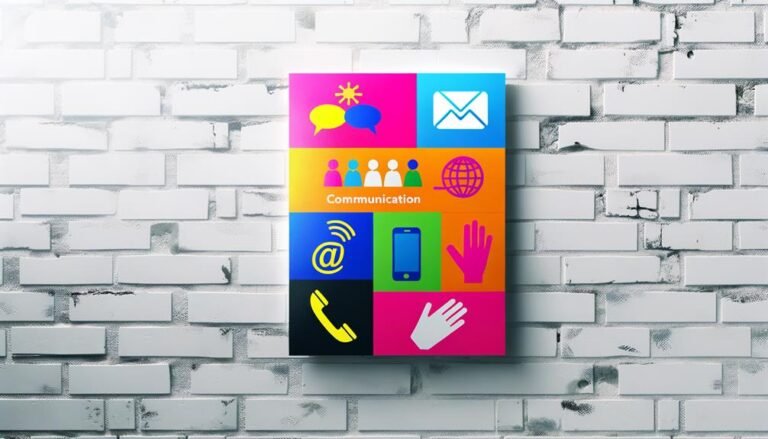Online Community Conflict Resolution Strategies
“In the midst of chaos, there is also opportunity.” – Sun Tzu
Online communities can face conflicts, from small misunderstandings to big disputes with many members. These spaces help people connect and work together but also bring challenges in managing conflicts. To keep online spaces peaceful, we need special strategies for solving conflicts online. With more people joining virtual communities, finding the right ways to solve conflicts is more important than ever.
Key Takeaways
- Understanding common causes of conflict in virtual environments is crucial.
- Effective communication techniques can significantly reduce misunderstandings.
- Emotional intelligence plays a vital role in managing conflicts online.
- Proactive conflict resolution strategies can create a positive community atmosphere.
- Solid leadership skills are essential for mediating and resolving disputes.
Understanding Common Causes of Conflict in Online Communities
Knowing what causes conflicts is key to keeping online groups peaceful. Many common issues often lead to disputes in these spaces.
Poor Communication
Poor communication is a big reason for online conflicts. Misunderstandings from text messages or emails can cause arguments. Using good conflict solving methods and listening well can fix these problems. Tips on how to mediate in communities help people deal with tough situations better.
Unclear Expectations
It’s important to have clear rules to avoid conflicts. Without clear guidelines, people might not know what’s expected, leading to more arguments. Setting clear rules and making sure everyone knows them helps keep things respectful and organized. Also, being clear about everyone’s roles can stop conflicts caused by unclear roles.
Different Cultural Backgrounds
Online groups often have people from different cultures. These differences can make things more interesting but can also cause misunderstandings. It’s important to be aware of and respect these differences. Encouraging people to share their cultural views can make the group stronger. Using special conflict solving methods for cultural differences can make things more peaceful and understanding.
Effective Communication Techniques for Conflict Resolution
Good communication is key in any relationship, especially when solving conflicts online. Using the right methods can make a big difference in how we handle disagreements. We’ll look at three important ways: active listening, being aware of non-verbal cues, and sending clear messages.
Active Listening Skills
Listening well is a big part of talking things out. It means really hearing what the other person is saying without jumping to conclusions. Important parts of active listening are:
- Giving each person a chance to share their thoughts and feelings.
- Not making quick judgments or giving unwanted advice.
- Using ‘I’ statements to share feelings without blaming others.
Getting better at listening helps us understand each other better and lowers the chance of fights. Studies show that focusing on the now helps keep conversations respectful and open.
Non-Verbal Communication Awareness
How we act without words is very important too. Paying attention to our body language and facial expressions helps us show empathy and seriousness. Here are some tips for better non-verbal communication:
- Keeping an open body language to help communication flow.
- Avoiding defensive postures like crossing arms.
- Choosing neutral words to avoid confusion.
Being aware of non-verbal cues helps us see and respect our differences. This is key to avoiding misunderstandings and fights.
Clear and Concise Messaging
It’s not just what we say but how we say it that matters. Making sure our messages are clear and to the point can stop confusion and stop conflicts from getting worse. Here are some tips for clear messaging:
- Setting clear expectations about roles and tasks.
- Being patient and quick to forgive to keep things positive.
- Talking about conflicts right away to stop them from growing.
Using these methods in your conflict resolution skills helps keep communication respectful and effective. This makes it easier to solve problems online.
Role of Emotional Intelligence in Conflict Management
In the world of effective conflict management, emotional intelligence is key, especially online where we can’t see each other’s faces. It helps us understand others, control our feelings, and build trust. This makes it easier to solve conflicts and keep online communities peaceful.
Empathy and Perspective-Taking
Empathy means putting yourself in someone else’s shoes to feel what they feel. It’s crucial for solving conflicts online. When we see things from another person’s point of view, we can talk things out better and understand each other.
Managing Emotional Responses
Handling your emotions is a big part of managing conflicts. Being able to stay calm helps avoid blowing things up and leads to clearer talks. Knowing how to keep your feelings in check is key to solving problems peacefully.
Building Trust and Respect
Trust and respect are vital in online groups to fix conflicts. Emotional smarts leads to actions that gain trust, like being honest and understanding. When people feel valued and heard, they’re more open to solving problems together.
Online Community Conflict Resolution Strategies
Handling conflicts in online communities needs a special plan for the digital world. By using top conflict solving tips and focusing on online disputes, leaders can make a peaceful place for everyone. Here’s a toolkit for dealing with disagreements:
- Acknowledge Conflicts: Recognize and openly talk about conflicts, as ignoring them won’t make them go away.
- Choose the Right Medium: For big conflicts, use video calls to see emotions and body language better, with tools like Zoom, Microsoft Teams, or Google Meet.
- Encourage Active Participation: Use features like polls for interactive ways to solve conflicts.
- Small Group Collaborations: Put people in smaller groups for working together on case studies, which helps with solving problems.
- Role-Playing: Add role-playing to practice solving conflicts in a pretend setting.
- Gamification: Make training more fun with quizzes and rewards to keep people interested.
- Empathy and Understanding: Start with empathy and trying to see things from others’ viewpoints, even if you don’t agree.
- Apply Proven Frameworks: Use strategies like the CPR (Condition-Prevent-Repair) framework, which works well in big groups.
- Brainstorm Solutions: Create a team environment by encouraging everyone to come up with different solutions.
- Evaluate Effectiveness: Check how well solutions work to make sure conflicts are really solved and to stop new ones.
These tips focus on solving conflicts online by building understanding, encouraging everyone to get involved, and using good ways to talk. Leaders can make their online communities stronger and more united by using these strategies.
How to Approach Tough Conversations in Virtual Spaces
Dealing with conflicts online needs careful planning and good communication skills. Since 35% of conflicts in virtual teams come from communication issues, it’s key to tackle these early. Here’s a guide to help you handle tough talks in online spaces.
Preparation and Research
Before starting a tough talk, spend time on preparation and research. Know the main reasons behind the conflict, like personal differences (25%) or work style variations (20%). Having data and thinking ahead can make the talk more effective.
Maintaining Calmness and Professionalism
It’s important to stay calm and professional during the talk. If issues aren’t dealt with quickly, about 50% of conflicts can get worse. Using effective communication techniques like listening well and clear speaking makes sure everyone feels understood and respected.
Follow-Up and Continuous Communication
Fixing conflicts doesn’t stop after one talk. Keeping in touch and continuous communication are key to stopping conflicts from coming back. Regular meetings can cut down on conflicts by 15%. Encouraging empathy and understanding among team members can lower conflicts by 25%. Trust can reduce conflicts in virtual teams by up to 40%, so it’s important to create a clear and supportive way of talking.
Utilizing Mediation and Third-Party Intervention
Mediation is a key way to solve conflicts by bringing in an impartial third party. This helps make disputes fair and balanced. It’s when a mediator helps both sides agree on a solution, which is vital for online communities.
There are three main types of mediators, each with different skills. Social network mediators know the community well, while independent mediators are neutral. Each type has its own strengths.
Mediators use various tactics to solve conflicts. The choice of tactic depends on the conflict’s stage, the power balance, and what the parties want. Picking the right tactic is crucial for success.
Good mediators do four key things. They build trust, make strong connections, explain the process, and get the parties to agree to mediate. This makes the process work well for everyone.
When mediators step in early, conflicts can be solved before they get worse. But if they come in later, they can understand the deeper reasons behind the conflict.
Mediation involves helping parties understand their needs and possible solutions. Mediators gather information to get a full picture of the conflict. They share this with the parties to help them see things clearly.
At the end, mediators create a plan to help the parties find common ground. This plan is key for fair and lasting solutions. It makes mediation a powerful tool for solving online community conflicts.
Recognizing and Addressing Bias in Conflict Situations
Online communities often face challenges due to biases that skew our judgment. Research by Carnegie Mellon University professors Linda Babcock and George Loewenstein shows that these biases make both sides in a conflict believe they are right. It’s crucial to acknowledge these biases for effective conflict management.
- Egocentric Bias: This makes people think they contribute more and are more in control. In disputes, many feel they are fairer and more rational than the other side.
- Opposition Bias: This bias undervalues any offer from the opposing side just because it comes from them.
- Us vs. Them Mentality: Groups in conflict often misjudge each other’s views, making things worse and harder to resolve.
Biases have real-world effects. Avoiding tough talks at work can cost companies a lot—up to $7,500 and more than seven workdays per issue. American businesses lose a staggering $359 billion yearly due to conflicts that aren’t solved. So, managing conflict well is key for fairness and efficiency.
Here are ways to beat these biases:
- Feedback: It helps negotiators spot their biases, leading to better negotiations.
- Conflict Resolution Training: This includes techniques to lessen cognitive mistakes and biases.
- Building Rapport and Trust: When both sides trust each other, negotiations work better and biases have less effect.
By using these strategies, leaders in communities can improve how they handle conflicts. This leads to a more cooperative online space.
Developing Conflict Resolution Skills for Community Leaders
Community leaders are key to keeping online spaces peaceful. They need to keep improving their skills to manage and solve conflicts. Training in conflict resolution and mediation skills helps them a lot.
Training and Workshops
Conflict resolution training through workshops gives leaders the tools they need. They learn about the causes of conflict and how to talk things out. Topics include:
- Understanding the roots of conflict
- Effective communication techniques
- Emotional intelligence and empathy
This training helps leaders build a strong skill set for their communities.
Role-Playing Scenarios
Role-playing is a key part of community leader mediation skills. It lets leaders practice in a safe setting. This way, they can:
- Test and improve their conflict resolution plans
- Feel more confident in handling real disputes
- Learn from mistakes without harm
Feedback and Reflection
Getting feedback and reflecting is key to getting better at conflict resolution. After training or role-playing, leaders get feedback to know their strengths and what they need to work on. Reflecting helps them to:
- See what worked well
- Spot areas to improve
- Plan strategies for future conflicts
By using feedback and reflection often, community leaders can get better at mediation. This makes online spaces more peaceful.
Overcoming “Us vs. Them” Mentalities
It’s key to tackle the “us vs. them” mindset to make online communities more welcoming and peaceful. By digging into the reasons behind this mindset and using smart strategies, leaders can make their communities more inclusive and work together better. Here’s how:
Identifying Shared Goals
One strong way to fix online conflicts is to find goals everyone shares. This makes the focus shift from what splits people to what brings them together. When folks see they’re aiming for the same things, they start to work together more.
Goals can be anything from making the user experience better to getting more people involved. By always talking about these goals, leaders help members see past their differences and focus on what they have in common.
Promoting Inclusivity and Understanding
It’s crucial to make online spaces welcoming to everyone to fight the “us vs. them” feeling. This means making sure everyone’s voice is heard and valued. Here’s how to do it:
- Inclusive language: Use simple words that everyone can understand. Stay away from terms that might leave some people out.
- Active moderation: Set rules that encourage kind talks and stop mean ones.
- Education and awareness: Host workshops and talks to teach members about being inclusive and respectful.
By building understanding and respect, leaders can reduce conflicts and make the community closer.
Encouraging Collaborative Problem-Solving
Getting people to work together to solve problems is another great way to beat the “us vs. them” feeling. When folks team up, they build trust and get closer. Here are some ideas to try:
- Group projects: Give tasks that need teamwork, so different views come together.
- Open forums: Set up places for members to share ideas and find solutions together.
- Recognition of efforts: Celebrate the wins that come from working together, showing the good in collaboration.
By using these strategies, online groups can turn conflicts into helpful talks. This leads to growth and better understanding among members.
Addressing Structural Conflicts in Online Communities
Online communities often face unique challenges due to unequal control or authority. To manage these conflicts well, it’s key to know the main causes and how to fix them. Studies show these conflicts can really affect the mood, motivation, and relationships in a community.
Conflicts can happen between people or groups because of different personalities, values, and beliefs. Without non-verbal cues, these differences can lead to misunderstandings. Using good conflict management, like clear and respectful talk, can help solve these problems.
Looking at real examples, like homeowner associations, shows how to deal with these conflicts online. It’s not just about solving conflicts but using them to make stronger, fairer relationships. This means acknowledging the issues, making amends, planning together, and keeping up positive changes.
Working together is a good way to strengthen relationships, statistics show. But ignoring conflicts is the worst approach, as they can come back. By taking time to think, figuring out the conflict’s cause, and finding solutions everyone agrees on, communities can become more united.
Reconciling means apologizing, asking for forgiveness, and working for fairness and justice. Creating a close atmosphere for talking, sharing personal stories, and getting different people involved are key steps. These actions help solve conflicts and also help the group work together better and push for change.
Effectively dealing with structural conflicts in online communities is about more than just solving problems. It’s about changing the way things work to make the online space more welcoming and respectful. By using these strategies, leaders can make the digital world a better place for everyone.
Best Practices for Conflict Prevention
Preventing conflicts is key in online communities. Using effective techniques can make these spaces more harmonious and engaging. Here are some tips to help:
Setting Clear Community Guidelines
Setting clear rules is a key conflict prevention method. Make sure everyone knows what’s expected of them. Include rules on behavior, what content is okay, and how to report issues. This helps avoid misunderstandings and keeps everyone aligned.
Regular Check-Ins and Feedback Loops
Checking in with your community often can prevent conflicts. Talk to members to hear their thoughts and solve problems early. This builds trust and helps spot issues before they get worse.
Empowering Moderators and Leaders
Give moderators and leaders the right training and tools to handle conflicts. They’re the first ones to deal with problems. Offer training on solving conflicts and preventing them. This way, they can keep the community calm and respectful.
Using these strategies can help prevent conflicts in online communities. While you can’t stop all disagreements, these methods make things better. They help create a place where people work together well.
Case Studies of Successful Conflict Resolution in Online Communities
Looking at real-world examples helps us see how to solve conflicts online. These cases show how to use strategies to keep communities together. They cover everything from social media to online learning platforms.
Example 1: Social Media Group
A big Facebook group faced a big conflict over what content was allowed. By using effective communication and conflict resolution strategies, the group changed for the better. They made sure everyone knew the rules and respected each other more. This made more people want to stay in the group.
Example 2: Virtual Learning Platform
On a huge online course, teachers and students often clashed. By having regular meetings and asking for feedback, they fixed many issues. Training the team to understand others and solve conflicts helped a lot. This led to happier students and more people joining in.
Example 3: Online Gaming Community
A gaming group known for its negativity changed for the better. They set clear rules and had people watching over the group in real-time. Talking openly about rules and caring about everyone’s feelings helped build trust. This made more people want to be part of the group.
These stories show how important it is to solve conflicts well in online groups. They prove that with the right approach, online communities can thrive.
Conclusion
As we move into 2024, the need for solving conflicts in online communities is more important than ever. This article has looked at online community conflict resolution strategies. These strategies help deal with the challenges of working together online.
One key point is the need for good communication. Misunderstandings in emails and different time zones can lead to conflicts. So, it’s vital to listen well and communicate clearly. This can stop conflicts before they start and help calm things down.
Emotional intelligence is also key. Being able to understand others, build trust, and manage feelings is crucial. Techniques like Verbal Aikido turn negative feelings into positive actions. These methods help leaders in online communities create places where everyone can work together well.
The success of online communities relies on using these strategies well. Setting rules and using technology for mediation are important steps. These practices help leaders and members work together peacefully. As online communities grow, using these conflict resolution methods is vital for keeping things positive and productive.
Source Links
- Community conflict resolution: 7 steps for solving conflicts in your community
- Five Conflict-Resolution Strategies for the Workplace
- Four Ways to Combat and Manage Conflict Within Your Online Community
- Handling conflict in an online environment (good vs bad)
- How can you resolve conflict in your online community?
- What do you do if conflicts arise in online communities?
- Effective Communication For Conflict Resolution – aifc
- Communication Tips for Conflict Resolution in the Workplace
- The Role Of Emotional Intelligence In Conflict Resolution – FasterCapital
- Emotional Intelligence Enables Community Managers To Swiftly Address And Resolve Conflicts
- The Moderating Role of Emotional Intelligence on the Relationship Between Conflict Management Styles and Burnout among Firefighters
- Boost Employee Conflict Resolution Skills with Interactive Online Training
- How to Resolve Conflict In Your Community (Explained in 5 Easy Steps)
- Managing Conflict in Virtual Teams | Hive Project Management
- How to Effectively Manage Conflict in Your Community
- Boosting Virtual Team Success: Communication Strategies for Leaders
- Summary of "The Mediation Process: Practical Strategies for Resolving Conflict"
- What are the Three Basic Types of Dispute Resolution? What to Know About Mediation, Arbitration, and Litigation
- 5 Conflict Resolution Strategies
- 5 Strategies for Conflict Resolution in the Workplace
- Summary of "Judgmental Biases in Conflict Resolution and How to Overcome Them"
- 27 Conflict Resolution Skills to Use with Your Team and Your Customers
- Chapter 20. Providing Information and Enhancing Skills | Section 6. Training for Conflict Resolution | Main Section
- Us v. Them – Why Collaboration Is Serious Business
- Ask a Negotiation Expert: Reaching Across the Divide
- Overcoming Us vs. Them | Hacker News
- Dealing with Conflicts Online
- What are effective strategies for resolving conflicts in online communities?
- Chapter 27. Working Together for Racial Justice and Inclusion | Section 9. Transforming Conflicts in Diverse Communities | Main Section
- Conflict Management – StatPearls – NCBI Bookshelf
- How to Handle Conflict and Controversy in Online Communities | Higher Logic
- Building Trust and Safety in Online Communities (2024)
- Case Studies
- Online Conflict Resolution: My New Normal in Professional Relationships
- Conflict Resolution in Online Communities: A Verbal Aikido Approach







